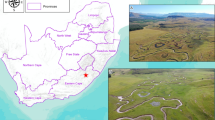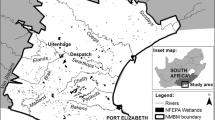Abstract
This study developed a Geographic Information System (GIS) framework using datasets such as light detection and ranging (lidar) data, soils, and land use/land cover for analyzing distribution and structure of over 10,000 coastal prairie wetlands (CPWs) around Galveston Bay, Texas, USA. Lidar data were used to estimate volumes and catchment areas. The CPWs were small (median 0.37 ha) with 72% of wetlands less than 1 ha in size. However, CPWs and their catchments occupy 40.8% of the land area within the study area. Field data from 12 CPWs were used to assess the accuracy of selected structural features. Error analysis suggests that relative elevation, land use/land cover and NWI datasets were reasonably accurate, while National Agriculture Imagery Program (NAIP) derived vegetation cover and Soil Survey Geographic Database (SSURGO) soils data were less reliable. This approach not only provides a detailed inventory of wetland resources, it also supports cumulative estimates of regional wetland functions that are critical to regional policy makers and wetland scientists. Additionally, correlations of geospatial datasets to field measurements should interest those who use geospatial datasets to estimate wetland condition.




Similar content being viewed by others
References
Antonić O, Hatic D, Pernar R (2001) DEM-based depth in sink as an environmental estimator. Ecological Modeling 138:247–254
Aronow S (1986) Surface geology of Jackson County. In: Miller WL (ed) Soil survey of Jackson County, Texas. USDA, Washington, DC, pp 91–95
Athern ND, Takekawa JY, Jaffe B, Hattenbach BJ, Foxgrover AC (2010) Mapping elevations of tidal wetland restoration sites in San Francisco Bay: comparing accuracy of aerial lidar with a singlebeam echosounder. Journal of Coastal Research 26:312–319
Boix D, Sala J, Moreno-Amich R (2001) The faunal composition of Espolla Pond (NE Iberian Peninsula): the neglected biodiversity of temporary waters. Wetlands 21:577–592
Bowen MW, Johnson WC, Egbert SL, Klopfenstein ST (2010) A GIS-based approach to identify and map playa wetlands on the High Plains, Kansas, USA. Wetlands 30:675–684
Brody SD, Highfield WE, Davis SE, Bernhardt SP (2008) A spatial-temporal analysis of section 404 wetland permitting in Texas and Florida: thirteen years of impact along the coast. Wetlands 28:107–116
Brooks RT, Hayashi M (2002) Depth-area-volume and hydroperiod relationships of ephemeral (vernal) forest pools in southern New England. Wetlands 22:247–255
Comer P, Goodin K, Tomaino A, Hammerson G, Kittel G, Menard S, Nordman C, Pyne M, Reid M, Sneddon L, Snow K (2005) Biodiversity values of geographically isolated wetlands in the United States. NatureServe. Available via DIALOG. http://www.natureserve.org/library/isolated_wetlands_05/isolated_wetlands.pdf. Accessed 10 Apr 2010
Downing JA, Prairie YT, Cole JJ, Duarte CM, Tranvik LJ, Striegl RG, McDowell WH, Kortelainen P, Caraco NF, Melack JM, Middelburg JJ (2006) The global abundance and size distribution of lakes, ponds, and impoundments. Limnology and Oceanography 51:2388–2397
Gamble D, Grody E, Undercoffer J, Mack JJ, Micacchio M (2007) An ecological and functional assessment of urban wetlands in Central Ohio Volume 2: Morphometric surveys, depth-area-volume relationships and flood storage function of urban wetlands in central Ohio. Ohio EPA Technical Report WET/2007–3B, Ohio Environmental Protection Agency, Columbus OH. Available via DIALOG. http://www.epa.state.oh.us/portals/35/wetlands/L919ReportVol_2_FunctionAssessUrbanWTLD.pdf. Accessed 13 July 2010
Guenther GC (2007) Airborne lidar bathymetry. In: Maune D (ed) Applications: the DEM users manual, 2nd edn. American Society for Photogrammetry and Remote Sensing, Bethesda, pp 253–320
Jacob JS, Lopez R (2005) A rapid assessment method using GIS and aerial photography. Contract Report No 582–3–53336, Galveston Bay Estuary Program. Available via DIALOG. http://www.urban-nature.org/publications/documents/WetlandLoss-FinalReportLowRes.pdf. Accessed 5 Dec 2010
Jin C (2008) Biodiversity dynamics of freshwater wetland ecosystems affected by secondary salinisation and seasonal hydrology variation: a model-based study. Hydrobiologia 598:257–270
Kishné AS, Morgan CLS, Miller WL (2009) Vertisol crack extent associated with gilgai and soil moisture in the Texas Gulf Coast Prairie. Soil Science Society of America Journal 73:1221–1230
Lane CR, D’Amico E (2010) Calculating the ecosystem service of water storage in isolated wetlands using lidar in north central Florida, USA. Wetlands. doi:10.1007/s13157-010-0085-z
Leibowitz SG (2003) Isolated wetlands and their functions: an ecological perspective. Wetlands 23:517–531
Lester J, Gonzalez L (2002) The state of the Bay, a characterization of the Galveston Bay ecosystem. (GBEP T–7). Galveston Bay Estuary Program. Available via DIALOG. http://gbic.tamug.edu/sobdoc/sob2/sob2page.html. Accessed 12 Jan 2010
McGowen JH, Brown LF Jr, Evens TF, Fisher WL, Groat CG (1976) Environmental geologic atlas of the Texas coastal zone – Port Lavas area. Univ. of Texas Bureau of Economic Geology, Austin
Miller WL, Bragg AL (2007) Soil characterization and hydrological monitoring project, Brazoria County, Texas, bottomland hardwood vertisols. United States Department of Agriculture, Natural Resources Conservation Service. Available via DIALOG. http://www.tx.nrcs.usda.gov/soil/docs/Bottomland%20Hardwood%20Vertisols%20Report.pdf. Accessed 16 Apr 2010
Pechmann JHK, Scott DE, Gibbons JW, Semlitsch RD (1989) Influence of wetland hydroperiod on diversity and abundance of metamorphosing juvenile amphibians. Wetlands Ecology and Management 1:3–11
Reutebuch SE, McGaughey RJ, Andersen H, Carson WW (2003) Accuracy of a high-resolution lidar terrain model under a conifer forest canopy. Canadian Journal of Remote Sensing 29:527–535
Sipocz A (2005) The Galveston bay wetland crisis, Texas. National Wetlands Newsletter 27: 1,17–18. Available via DIALOG. http://repositories.tdl.org/tamug-ir/bitstream/handle/1969.3/27562/11032-Galveston%20Bay%20Wetland%20Crisis.pdf?sequence=1. Accessed 5 Jan 2009
Smeins FE, Diamond DD, Hanselka CW (1991) Coastal prairie. In: Coupland RT (ed) Ecosystems of the world 8A. Natural grasslands: introduction and western hemisphere. Elsevier, New York
United States Fish and Wildlife Service (USFWS) (2004) National standards and quality components for wetlands, deepwater and related habitat mapping. United States Fish and Wildlife Service, Arlington VA. Available via DIALOG. www.fws.gov/stand/standards/dl_wetlands_National%20Standards.doc. Accessed 5 Apr 2011
Whigham DF, Lee LC, Brinson MM, Rheinhardt RD, Rains MC, Mason JA, Kahn H, Ruhlman MB, Nutter WL (1999) Hydrogeomorphic (HGM) assessment-a test of consistency. Wetlands 19:560–569
Wilcox B, Dex D, Jacob J, Sipocz A (2011) Evidence of surface connectivity for Texas gulf coast depressional wetlands. Wetlands. doi:10.1007/s13157-011-0163-x
Wilen BO, Bates MK (1995) The US fish and wildlife service’s national wetlands inventory project. Vegetatio 118:153–169
Zahina JG, Saari K, Woodruff DA (2001) Functional assessment of South Florida freshwater wetlands and models for estimates of runoff and pollution loading. South Florida Water Management District, Tech. Publ. WS–9. South Florida Water Management District, West Palm Beach, FL. Available via DIALOG. http://www.sfwmd.gov/portal/page/portal/pg_grp_tech_pubs/PORTLET_tech_pubs/ws-9.pdf. Accessed 11 Dec 2009
Acknowledgments
We thank Steven Johnston and the Galveston Bay Estuary Program, the Texas Commission on Environmental Quality, the Texas General Land Office, the Environmental Protection Agency, and the Association of American Geographers Anne White Fund for funding this research, Andy Sipocz, John Jacobs, Wes Miller, Mark Kramer, Jim Herrington, Jamie Schubert and many others for sharing their knowledge of coastal prairie wetlands, Dow Chemical, Armand Bayou Nature Center, Don Wilcox and other private landowners that provided access to study sites, and finally Baylor University for supporting this project.
Author information
Authors and Affiliations
Corresponding author
Rights and permissions
About this article
Cite this article
Enwright, N., Forbes, M.G., Doyle, R.D. et al. Using Geographic Information Systems (GIS) to Inventory Coastal Prairie Wetlands Along the Upper Gulf Coast, Texas. Wetlands 31, 687–697 (2011). https://doi.org/10.1007/s13157-011-0184-5
Received:
Accepted:
Published:
Issue Date:
DOI: https://doi.org/10.1007/s13157-011-0184-5




